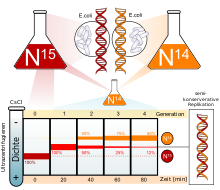Meselson steel experiment
The biologists Matthew Meselson and Franklin Stahl developed the Meselson-Stahl experiment , published in 1958 and named after them , with which it can be demonstrated that the replication of the DNA is semiconservative ( semi-conservative ), i.e. the genetic material of the daughter cells depending on the cell division Half consists of the genetic information of the mother cell and half is newly synthesized .
In addition to the semiconservative , the hypotheses of the conservative and the disperse replication were also discussed beforehand :
- With conservative replication , the mother DNA is completely retained and the copies of its two single strands are put together to form a new double strand.
- In semi-conservative replication , half of the mother DNA is retained in each daughter molecule. The other half is newly added.
- The disperse replication (also dispersive replication ) proceeds in a similar way, here too half of the mother DNA is retained in each daughter DNA, the other half is replaced by new nucleotides . However, the replacement mechanism is completely different - because the nucleotides of the mother DNA alternate with the newly added nucleotides.
For their experiment, the researchers first grew bacteria on a nutrient medium that only contained a nitrogen isotope with a mass number of 15. This was then integrated into their DNA by the bacteria. Bacteria of this strain were then applied to a nutrient medium which contained nitrogen with a mass number of 14. After 20 minutes, bacteria of the first successor generation (F1 generation) were removed and their genetic material was subjected to density gradient centrifugation . It was found that the sedimentation level of the bacterial DNA was exactly between the reference levels of DNA which exclusively contained 14 or 15 u nitrogen. This meant that the conservative theory could be ruled out, as otherwise two sedimentation levels would have had to form at the level of the reference levels.
In order to be able to decide which of the other two theories is correct, the process was repeated with individuals of the F2 generation. It was found that half of the bacterial genome sedimented in the level of the F1 generation and half in the 14 u reference level. This corresponds exactly to the predictions of the semiconservative theory, but does not completely rule out disperse replication. Theoretically, the fragments could be preserved in a disperse replication and always new and old DNA fragments alternate (due to a mechanism), whereby the density of the DNA would behave in the same way as in the experiment. In order to completely rule out disperse replication, Meselson and Stahl heated the DNA of the F1 generation in the medium of the density gradient centrifuge for 30 min at 100 ° C, whereby the double-stranded DNA was split into single strands (Meselson and Stahl observed that the weight of the molecules was roughly halved) . In the density gradient centrifugation , two bands were now found that matched the bands of heated pure N15 and N14 DNA. This made it possible to rule out disperse replication.
See also
literature
- Meselson, M. and Stahl, FW: The Replication of DNA in Escherichia coli . In: PNAS . 44, 1958, pp. 671-82. doi : 10.1073 / pnas.44.7.671 . PMID 16590258 .
- Frederic L. Holmes Meselson, Stahl and the Replication of DNA: A history of the most beautiful experiment in biology , Yale University Press 2001
Web links
- Discovery of semi-conservative replication
- Meselson-Stahl experiment
- Biology course: Molecular genetics: requirements for a genetic material
Individual evidence
- ^ Matthew Meselson and Franklin W. Stahl: The replication of DNA in Escherichia coli *. Retrieved April 22, 2017 (English).

